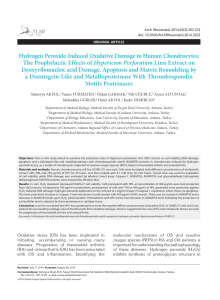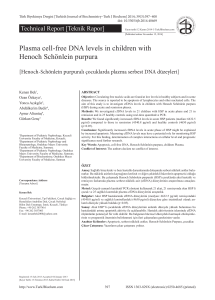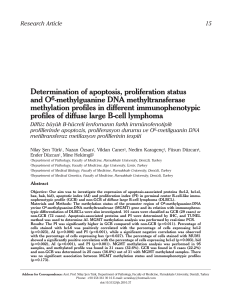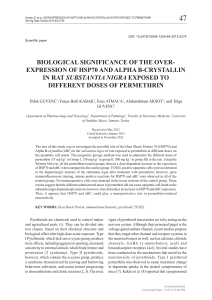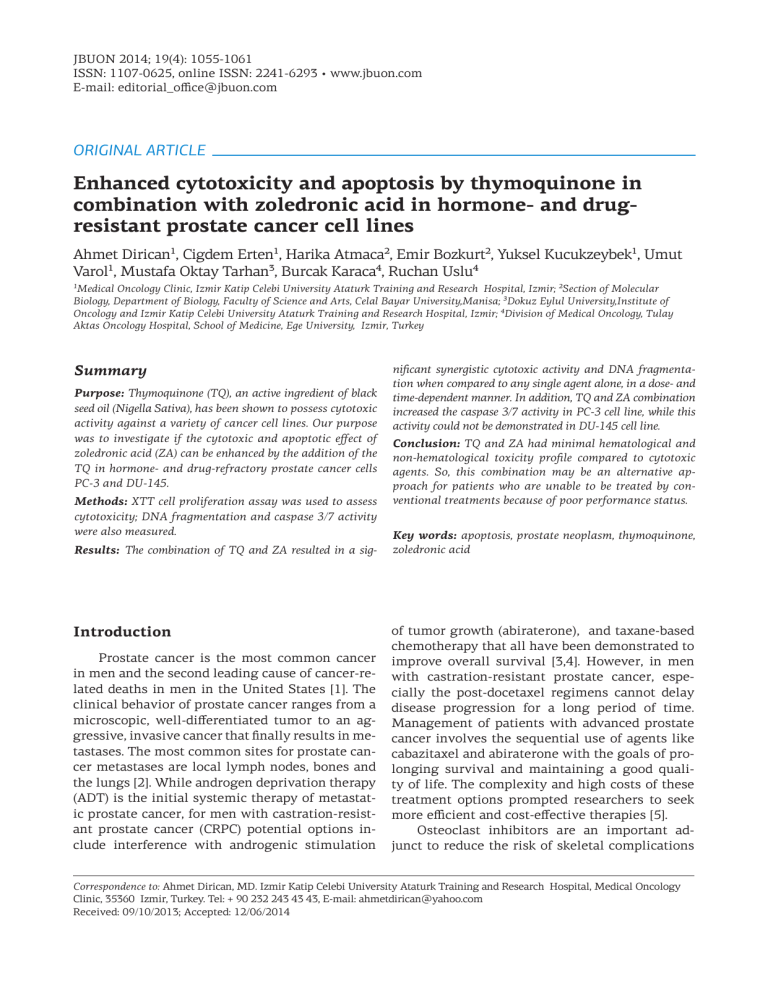
JBUON 2014; 19(4): 1055-1061
ISSN: 1107-0625, online ISSN: 2241-6293 • www.jbuon.com
E-mail: [email protected]
ORIGINAL ARTICLE
Enhanced cytotoxicity and apoptosis by thymoquinone in
combination with zoledronic acid in hormone- and drugresistant prostate cancer cell lines
Ahmet Dirican1, Cigdem Erten1, Harika Atmaca2, Emir Bozkurt2, Yuksel Kucukzeybek1, Umut
Varol1, Mustafa Oktay Tarhan3, Burcak Karaca4, Ruchan Uslu4
1Medical Oncology Clinic, Izmir Katip Celebi University Ataturk Training and Research Hospital, Izmir; 2Section of Molecular
Biology, Department of Biology, Faculty of Science and Arts, Celal Bayar University,Manisa; 3Dokuz Eylul University,Institute of
Oncology and Izmir Katip Celebi University Ataturk Training and Research Hospital, Izmir; 4Division of Medical Oncology, Tulay
Aktas Oncology Hospital, School of Medicine, Ege University, Izmir, Turkey
Summary
Purpose: Thymoquinone (TQ), an active ingredient of black
seed oil (Nigella Sativa), has been shown to possess cytotoxic
activity against a variety of cancer cell lines. Our purpose
was to investigate if the cytotoxic and apoptotic effect of
zoledronic acid (ZA) can be enhanced by the addition of the
TQ in hormone- and drug-refractory prostate cancer cells
PC-3 and DU-145.
Methods: XTT cell proliferation assay was used to assess
cytotoxicity; DNA fragmentation and caspase 3/7 activity
were also measured.
Results: The combination of TQ and ZA resulted in a sig-
Introduction
Prostate cancer is the most common cancer
in men and the second leading cause of cancer-related deaths in men in the United States [1]. The
clinical behavior of prostate cancer ranges from a
microscopic, well-differentiated tumor to an aggressive, invasive cancer that finally results in metastases. The most common sites for prostate cancer metastases are local lymph nodes, bones and
the lungs [2]. While androgen deprivation therapy
(ADT) is the initial systemic therapy of metastatic prostate cancer, for men with castration-resistant prostate cancer (CRPC) potential options include interference with androgenic stimulation
nificant synergistic cytotoxic activity and DNA fragmentation when compared to any single agent alone, in a dose- and
time-dependent manner. In addition, TQ and ZA combination
increased the caspase 3/7 activity in PC-3 cell line, while this
activity could not be demonstrated in DU-145 cell line.
Conclusion: TQ and ZA had minimal hematological and
non-hematological toxicity profile compared to cytotoxic
agents. So, this combination may be an alternative approach for patients who are unable to be treated by conventional treatments because of poor performance status.
Key words: apoptosis, prostate neoplasm, thymoquinone,
zoledronic acid
of tumor growth (abiraterone), and taxane-based
chemotherapy that all have been demonstrated to
improve overall survival [3,4]. However, in men
with castration-resistant prostate cancer, especially the post-docetaxel regimens cannot delay
disease progression for a long period of time.
Management of patients with advanced prostate
cancer involves the sequential use of agents like
cabazitaxel and abiraterone with the goals of prolonging survival and maintaining a good quality of life. The complexity and high costs of these
treatment options prompted researchers to seek
more efficient and cost-effective therapies [5].
Osteoclast inhibitors are an important adjunct to reduce the risk of skeletal complications
Correspondence to: Ahmet Dirican, MD. Izmir Katip Celebi University Ataturk Training and Research Hospital, Medical Oncology
Clinic, 35360 Izmir, Turkey. Tel: + 90 232 243 43 43, E-mail: [email protected]
Received: 09/10/2013; Accepted: 12/06/2014
1056
Synergistic effects of TQ and ZA in prostate cancer cells
of bone metastases. ZA, a nitrogen-containing biphosphonate, shows a great effect in slowing down
the progression of skeletal-related events in CRPC
patients [6]. In addition to having bone resorption
inhibiting properties, ZA also exhibits anti-tumor
effects [7]. The anti-tumor effects of ZA were interpreted as intervention in the mechanisms of
osteoclastogenesis, apoptosis, angiogenesis inhibition and inhibition of tumor cell adhesion
[8]. Biphosphonates were usually combined with
chemotherapeutics in order to enhance cytotoxicity. Another benefit of combination therapies is
that they reduce development of drug resistance
since a tumor is less likely to be resistant to multiple drugs simultaneously.
TQ is one of the major bioactive component
(30-48%) of Nigella sativa L, a plant that is named
as black seed or black cumin [9]. The steam-distilled essential oil of it was investigated for its antioxidant and anti-inflammatory properties [10].
TQ has also been shown to have anti-neoplastic
activity against a variety of cancer cell lines [11].
Its cytotoxic and pro-apoptotic effects were predominantly demonstrated in prostate cancer cell
lines such as PC-3, LNCaP and DU-145 [12,13].
The aim of this study was to evaluate the additive and/or synergistic cytotoxic and apoptotic
effects of TQ and ZA combination on PC-3 (hormone resistant and chemotherapy sensitive) and
DU-145 (hormone and chemotherapy resistant)
prostate cancer cell lines.
Methods
Cell lines and reagents
Human prostate cancer cell lines (PC-3 and DU145) were obtained from ICLC (Genova, Italy). The
cells were grown as monolayer adherent cell lines
and were routinely cultured in RPMI 1640 supplemented with 10% heat-inactivated fetal bovine serum
(FBS), 1% L-glutamine, 1% penicillin-streptomycin in
75 cm2 polystyrene flasks (Corning Life Sciences, UK)
and maintained at 37 °C in a humidified atmosphere
with 5% CO2. Growth and morphology were monitored
and cells were passaged when they had reached 90%
confluence. Cell culture supplies were obtained from
Biological Industries (Israel). TQ was purchased from
Sigma-Aldrich St. Louis, MO and a stock solution of TQ
(10 µM) was prepared in dimethyl sulphoxide (DMSO).
ZA was a generous gift from Novartis Pharmaceuticals
Inc (Basel, Switzerland) and prepared in distilled water
(10 µM). Final dilutions were made immediately before
use, and new stock solutions were prepared for each experiment. DMSO concentration in the assay was <0.1%,
which had no cytotoxic effect on the tumor cells. All
other chemicals, unless mentioned, were purchased
JBUON 2014; 19(4): 1056
from Sigma Chemical Co.
XTT viability assay
For the viability assay, after verifying cell viability
using the trypan blue dye-exclusion test in a Cellometer automatic cell counter (Nexcelom Inc., Lawrence,
MA, USA), cells were seeded at 104/well in 200 µl into
96-well flat-bottom microtitre plates with or without
different concentrations of the drugs. Plates were incubated at 37 °C in a 5% CO2 incubator for the indicated periods. At the end of incubation, 100 µl of XTT
(2,3-bis (2-methoxy-4-nitro-5-sulfophenyl)-5-[(phenylamino)carbonyl]-2H-tetrazolium hydroxide) (Roche
Applied Science, Mannheim, Germany) were added
to each well, and plates were incubated at 37 °C for
a further 4 hrs. Absorbance was measured at 450 µM
against a reference wavelength at 650 µM using a microplate reader (DTX 880 Multimode Reader, Beckman
Coulter, Fullerton, CA, USA). The mean of triplicate experiments for each dose was used to calculate the 50%
inhibitory concentration (IC50) and the combination index (CI) values.
Evaluation of apoptosis by DNA fragmentation analysis
Apoptosis was measured with a Cell Death Detection ELISA Plus Kit (Roche Applied Science, Germany)
according to the manufacturer’s instructions. The relative amounts of mono- and oligo-nucleosomes generated from the apoptotic cells were quantified using
monoclonal antibodies directed against DNA and histones by ELISA. Briefly, the cytoplasmic fraction of the
untreated control, TQ-, ZA- and combination treated
cells were transferred onto a streptavidin-coated plate
and incubated for 2 hrs at room temperature with a
mixture of peroxidase conjugated anti-DNA and biotin
labeled anti-histone. The plate was washed thoroughly,
incubated with 2,29-azino-di-[3-ethylbenzthiainesulphonate] diammonium salt, and the absorbance was
measured at 405 µM with a reference wavelength at
490 µM (DTX 880 Multimode Reader, Beckman Coulter, Fullerton, CA, USA).
Caspase 3/7 activity assay
Caspase 3/7 activity was evaluated by using the
Caspase-Glo 3/7 Assay (Promega, Madison, WI) according to the manufacturer’s instructions. Briefly, 104 prostate cancer cells/well were plated in a 96-well plate in
100 μl culture medium with increasing concentrations
of trabectedin for 72 hrs. Then 100 μl of Caspase-Glo
3/7 reagent were added to each well and the plates were
incubated at room temperature for 1 h. Finally, the luminescence of each sample was measured by DTX 880
Multimode Reader (Beckman Coulter, Miami, FL).
Statistics
All experiments were conducted in triplicate and
the results expressed as the mean ± SD, with differenc-
Synergistic effects of TQ and ZA in prostate cancer cells
Table 1. The IC50 value of TQ and ZA on human prostate cancer cells
Cell line
TQ (µM)
ZA (µM)
PC-3
55.3
95.0
DU-145
51.0
72.9
1057
Table 2. Combination index (CI) values of TQ or ZA
alone and their combination on growth inhibition of
PC-3 and DU-145 cells. Combination index (CI) values
were calculated from the XTT cell proliferation assays,
according to CalcuSyn software. The CI was used to express synergism (CI<1), additive effect (CI=1), or antagonism (CI>1), where CI < 0.5 represents strong synergism
CI value - Interpretation
es assessed statistically by Student’s t-test. Statistical
significance was set at p<0.05. The median dose-effect
analysis was used to assess the interaction between
agents. Determination of the synergistic vs additive
vs antagonistic cytotoxic effects of the combined treatment of cells with TQ and ZA were assessed by Biosoft
CalcuSyn program (Ferguson, MO, USA). CI was used
to express synergism (CI <1), additive effect (CI=1), or
antagonism (CI >1) [14].
Results
Effects of TQ and ZA on the viability of PC-3 and DU145 prostate cancer cells
To evaluate the cytotoxic effects of ZA and TQ
alone on the viability of human prostate cancer
cells, PC-3 and DU-145 were exposed to increasing concentrations of ZA (20 to 120 µM) and TQ
(1 to 120 µM) for 24, 48 and 72 hrs, and XTT cell
proliferation assay was performed. ZA and TQ
alone decreased the cell viability in a time- and
dose-dependent manner both in PC-3 and DU-145
cells. There was 18.5, 36.5, and 85 % decrease in
cell viability of PC-3 cells exposed to 40, 100,
and 120 µM of ZA, respectively, when compared
to untreated controls at 72 hrs (p<0.05). In addition, there was 35, 58.5, and 59 % decrease in cell
viability of DU-145 cells exposed to 40, 100, and
120 µM of ZA, respectively, when compared to untreated controls at 72 hrs (p< 0.05). Highest cytotoxicity was observed at 72 hrs and IC50 values of
ZA were found to be 95.0 and 72.4 µM in PC-3 and
DU-145 cells, respectively (Table 1).
We also examined the effect of TQ on PC-3 and
DU-145 cells. There was 10, 13, and 54 % decrease
in cell viability of PC-3 cells exposed to 10, 20,
and 40 µM of TQ, respectively, when compared to
untreated controls at 72 hrs (p<0.05). In DU-145
cells, there was 6, 12, and 36 % decrease in cell
viability of DU-145 cells exposed to 10, 20, and 40
µM of TQ, respectively (p<0.05). Highest cytotoxicity was observed at 72 hrs and IC50 values of TQ
in PC-3 and DU-145 cells were found to be 55.3
and 51 µM in PC-3 and DU-145 cells, respectively.
Synergistic effects of TQ and ZA in PC-3 and DU-145
prostate cancer cells
To examine the possible synergistic/additive
Combination
PC-3
DU-145
40 TQ + 60 ZA
0.429-strong
synergism
0.467- strong
synergism
60 TQ + 40 ZA
0.421- strong
synergism
0.535synergism
60 TQ + 60 ZA
0.404- strong
synergism
0.429- strong
synergism
effects of ZA and TQ combination, PC-3 and DU145 cells were exposed to different concentrations
of each agent alone, and in combination of both
for 24, 48 and 72 hrs. Figures 1A and 1B clearly
demonstrate the synergism between TQ and ZA
on prostate cancer cells. We also calculated the
CI values for these agents from the XTT cell proliferation assay by using the CalcuSyn software.
Our results indicated that 60 µM ZA and 40 µM
TQ achieved 22 and 60% decrease, respectively,
in cell viability of PC-3 cells but the combination
of both resulted in 80% decrease in cell viability
(p<0.05) (Figure 1A). In DU-145 cells, 40 µM ZA
and 60 µM TQ showed 18.5% and 59% decrease,
respectively, in cell viability, but the combination
of both resulted in 79% decrease in cell viability
(p<0.05) (Figure 1B). The concentrations for each
agent, found to be strongly synergistic in PC-3
and DU-145 cells, are presented in Table 2.
Effects of the sequential treatment
Combination of ZA and TQ resulted in significant synergism at 72 hrs. Sequential administration of the agents were carried out to see if
either of these agents enhances the other one’s
effect and to understand whether the synergism
depended on which agent applied first. We examined the effect of sequential treatment of PC-3 and
DU-145 cells with either ZA or TQ and subsequent
treatment with the second agent. Pretreatment of
tumor cells with ZA for 36 hrs, washing and then
treating them for an additional 36 hrs with TQ resulted in synergistic cytotoxicity in PC-3 and DU145 cells. Also, pretreatment of tumor cells with
TQ for 36 hrs, washing and then treating them for
an additional 36 hrs with ZA resulted in synergistic cytotoxicity in PC-3 and DU-145 cells (data
not shown). We concluded that synergistic cytoJBUON 2014; 19(4): 1057
1058
Synergistic effects of TQ and ZA in prostate cancer cells
Figure 1. Effects of combinatorial treatment of ZA
with TQ on the viability of PC-3 (A) and DU-145 (B).
Cytotoxicity was determined by the XTT cell viability
test at 72 hrs. *p<0.05 compared to the control group.
Figure 2. Effects of combinatorial treatment of ZA
with TQ on the percent changes in DNA fragmentation of PC-3 (A) and DU-145 (B) cells were determined
to show apoptosis. The bar graphs values represent
the means ±SD of three experiments. *p<0.05 compared to each agent alone.
toxicity was observed no matter which agent was
applied first in both cell lines.
tion Kit. Our results clearly showed that ZA and
TQ alone induced apoptosis in a dose-dependent
manner. In 60 μM ZA or 40 µM TQ alone exposed
PC-3 cells, 4.8- or 3.76-fold increase respectively
was observed, but in the combined treatment 7.3fold increase was noticed in DNA fragmentation
as compared to untreated controls (p<0.05); when
PC-3 cells was exposed to 40 μM ZA or 60 µM
TQ alone, 3.6- or 4.13-fold increase in DNA fragmentation was observed respectively, but their
combined treatment resulted in 8.26-fold increase
Apoptotic effects of TQ and ZA alone or in combination in PC-3 and DU-145 prostate cancer cells
To examine the induction of apoptosis in response to ZA and TQ alone or in combination,
human prostate cancer cells were exposed to increasing concentrations of drugs for 72 hrs and
the levels of mono- and oligo-nucleosome fragments were quantified using Cell Death DetecJBUON 2014; 19(4): 1058
Synergistic effects of TQ and ZA in prostate cancer cells
in DNA fragmentation as compared to untreated
controls (p<0.05). In addition to 60 μM ZA or 60
µM TQ alone exposed PC-3 cells, 4.8- or 4.13-fold
increase in DNA fragmentation was observed respectively, but their combined treatment resulted in 9.06-fold increase in DNA fragmentation as
compared to untreated controls (p<0.05) (Figure
2A). There were 6.4- or 8.3-fold increase in DNA
fragmentation in 60 μM ZA or 60 µM TQ exposed
in DU-145 cells respectively, while the combination treatment resulted in 8.53-fold increase in
DNA fragmentation as compared to untreated
controls (p<0.05). However, there was 6- or 8.3fold increase in DNA fragmentation in 40 μM ZA
or 60 µM TQ alone exposed DU-145 cells respectively, but 8.0-fold increase was observed in the
combined treatment as compared to untreated
controls (p>0.05) (Figure 2B).
Caspase 3/7 enzyme activity in PC-3 and DU-145
cells exposed to combination treatment
Next, we investigated the molecular mechanisms underlying apoptosis induced by combination treatment in prostate cancer cells. For this
aim, we evaluated the possible role of the executioner DEVD caspases 3/7. The combination of ZA
with TQ induced caspase 3/7 activity in a synergistic manner as compared to any agent alone in
PC-3 cells at 72 hrs (p<0.05). However, the combination of ZA with TQ did not affect the activation
of caspase 3/7 activity in DU-145 cells (p>0.05).
Discussion
This study provided evidence that treatment
of PC-3 and DU-145 prostate cancer cells with a
combination of TQ and ZA resulted in a significant synergistic cytotoxic activity and apoptosis.
This effect was observed in a dose- and time-dependent manner. Besides, this is the first study in
the literature evaluating the efficiency of TQ and
ZA combination in prostate cancer cell lines.
The anticancer effects of TQ depend on the
inhibition of proliferation, angiogenesis, invasion
and metastasis [15]. TQ reduces DNA synthesis in
PC-3, DU-145 and LNCaP cell lines in a dose- and
time-dependent manner while it has no effect in
benign prostatic hyperplasia (BPH-1) epithelial
cell line. In this study, TQ ceased the LNCaP cells
between G1 and S phase and this inhibition was
found to be related with the cell cycle regulatory
protein E2F-1 and androgen receptor suppression
[16]. Another study investigated the mechanism of
action of TQ in androgen receptor (AR)-independ-
1059
ent (C4-2B) and AR naive (PC-3) prostate cancer
cells. Exposure to TQ inhibited the growth of both
C4-2B and PC-3 cells, with IC50 values of approximately 50 and 80 μmol/L, respectively. Within
one hour, TQ increased reactive oxygen species
(ROS) levels (3-fold) and decreased glutathione
(GSH) levels (60%) in both cell types. TQ did not
increase the activity of caspases and the caspase
inhibitor z-VAD-FMK did not decrease TQ-induced apoptosis. Furthermore, Koka et al. concluded that TQ-induced cell death was primarily
due to increased ROS generation and decreased
GSH levels, and was independent of AR activity
[12]. Zubair et al. observed that TQ even at lower
concentrations (5-10 µM) showed cytotoxicity in
PC-3 and LNCaP cell lines and its cytotoxic effect
was mediated through apoptotic pathways [17].
They also proved the dependency of TQ mediated apoptosis on ROS as several antioxidants like
catalase, superoxide dismutase and thiourea were
used to inhibit the apoptotic effect.
In our study, IC50 values for TQ were found to
be similar with previous published studies (PC-3
IC50:55.3; DU-145 IC50:55) [12,18]. TQ in combination with ZA had a strongly synergistic cytotoxic
effect, which was detected with the CalcuSyn software. TQ and ZA combination inhibited the cell
viability of hormone- and drug-refractory prostate cancer cells at in vivo achievable therapeutic
concentrations. Additionally, we demonstrated
that there were drug concentration dependent
increases in DNA fragmentation and caspase 3/7
enzyme activity in PC-3 cells exposed to TQ / ZA
combination but did not observe caspase activation in DU-145 cells. The reason of apoptosis in
our DU-145 cell lines may be due to the ROS-dependent apoptotic mechanisms of TQ as there was
no role of caspase activation like in the studies of
Koka et al. and Zubair et al. [12,17].
For frail or elderly prostate cancer patients,
the tolerance of cytotoxic chemotherapeutics may
be lower. TQ and ZA combination seems to be less
toxic than docetaxel or cabazitaxel-based treatments. So, it may be a more appropriate treatment option for patients with low performance
status. Anticancer drugs are generally used in
combination in order to prevent drug resistance
and increase their efficiency. With respect to this,
TQ was combined with various chemotherapeutic drugs in different cancer cell lines. Effenberger-Neidnicht et al. found a significant growth inhibition by doxorubicin in HL-60 leucemia cells
and multidrug-resistant MCF-7/TOPO cells when
TQ had been added [19]. Another study demonJBUON 2014; 19(4): 1059
1060
Synergistic effects of TQ and ZA in prostate cancer cells
strated that combination of TQ and cisplatin was
well tolerated and significantly reduced the tumor
volume without additional toxicity in non-small
and small cell cancer cell lines [20].
Zoledronic acid, either alone or in combination with other drugs, showed cytotoxicity on
prostate cancer cells in several studies [21,22].
It also reduced the incidence of skeletal-related
events better than placebo in men with castration-resistant metastatic prostate cancer patients
[23]. Therefore, ZA is commonly used in all treatment lines of prostate cancer patients with bone
metastasis. Despite these benefits, ZA has some
serious adverse effects like renal toxicity and jaw
osteonecrosis which limits its usage. Renal toxicity of ZA is thought to be due to acute tubular
necrosis [24]. On the other hand, TQ has some
protective effects on cisplatin-induced nephrotoxicity, significantly reducing serum urea and creatinine, and significantly improving polyuria and
creatinine clearance [25]. From this aspect, it is
rational to think that TQ in combination with ZA
may ameliorate or even prevent ZA-induced renal
toxicity. The pathophysiology of jaw osteonecrosis in patients taking bisphosphonates depends
on the impairment of bone and vascular repair
mechanisms, and impaired angiogenesis [26,27].
Kara et al. evaluated the effect of systemic TQ in a
References
1. Howlader N, Noone AM, Krapcho M et al. SEER
Cancer Statistics Review, 1975–2008, National Cancer Institute. Bethesda, MD: http://seer.cancer.gov/
csr/1975_2008/. Accessed March 28, 2013.
2. Epstein JI. Pathology of prostatic neoplasia. In: Wein
AJ, Kavoussi LR, Novick AC, Partin AW, Peters CA
(Eds): Campbell-Walsh Urology (9th Edn). Philadelphia: W.B. Saunders, 2007, pp 2874–2875.
3. Fizazi K, Scher HI, Molina A et al. COU-AA-301 Investigators. Abiraterone acetate for treatment of metastatic castration-resistant prostate cancer: final overall survival analysis of the COU-AA-301 randomised,
double-blind, placebo-controlled phase 3 study. Lancet Oncol 2012;13:983-992.
4. Berthold DR, Pond GR, Soban F, de Wit R, Eisenberger
M, Tannock IF. Docetaxel plus prednisone or mitoxantrone plus prednisone for advanced prostate cancer:
updated survival in the TAX 327 study. J Clin Oncol
2008;26:242-245.
5. Zhong L, Pon V, Srinivas S et al. Therapeutic options
in docetaxel-refractory metastatic castration-resistant
prostate cancer: a cost-effectiveness analysis. PLoS
JBUON 2014; 19(4): 1060
rat rapid maxillary expansion model and demonstrated that systemic use of TQ may be effective
in accelerating new bone formation, number of
capillaries and the amount of inflammatory cells
in maxillary sutures [28]. As a result of these data,
in addition to its various chemopreventive effects,
TQ may also have a role in preventing the osteonecrosis of jaw which is a complication of longterm, high-dose bisphosphonate therapy [29-31].
Conclusion
This is the first report of a synergistic combination of ZA and TQ, which inhibits cell viability
and induces apoptosis in PC-3 and DU-145 prostate cancer cells. The results of this study present
the translational potential of our in vitro findings
and offer a basic rationale for the design of new
combinatorial strategies with ZA and phosphatase
inhibitors for the treatment of prostate cancer,
which may develop resistance to conventional
therapy. As prostate cancer is mainly a disease of
elderly men, new therapeutic strategies with fewer side effects than cytotoxic treatment are very
important. So, this new combination strategy may
be an alternative approach for poor performance
status patients who are unable to be treated by
conventional treatments.
One; 2013 22;8(5):e64275.
6. Saad F, Gleason DM, Murray R et al. Zoledronic Acid
Prostate Cancer Study Group. Long-term efficacy of
zoledronic acid for the prevention of skeletal complications in patients with metastatic hormone-refractory prostate cancer. J Natl Cancer Inst 2004;96:879882.
7. Dumon JC, Journe F, Kheddoumi N, Lagneaux L, Body
JJ. Cytostatic and apoptotic effects of bisphosphonates
on prostate cancer cells. Eur Urol 2004;45:521-528.
8. Green JR. Biphosphonates: preclinical review. Oncologist 2004;9 (Suppl 4):3-13.
9. Hajhashemi V, Ghannadi A, Jafarabadi H. Black cumin
seed essential oil, as a potent analgesic and antiinflammatory drug. Phytother Res 2004;18:195-199.
10. Trang NT, Wanner MJ, Phuong le VN, Koomen GJ,
Dung NX. Thymoquinone from Eupatorium ayapana.
Planta Med 1993;59:99.
11. Shoieb AM, Elgayyar M, Dudrick PS, Bell JL, Tithof
PK. In vitro inhibition of growth and induction of apoptosis in cancer cell lines by thymoquinone. Int J
Oncol 2003;22:107-113.
12. Koka PS, Mondal D, Schultz M, Abdel-Mageed AB,
Synergistic effects of TQ and ZA in prostate cancer cells
Agrawal KC. Studies on molecular mechanisms of
growth inhibitory effects of thymoquinone against
prostate cancer cells: role of reactive oxygen species.
Exp Biol Med (Maywood) 2010;235:751-760.
13. Ross Richards L, Wilson F, Benghuzzi H, Tucci M.
The role of estrogen, testosterone, and parathyroid
hormones in combination with conventional and sustained antioxidant treatment on lncap cells. Biomed
Sci Instrum 2009;45:268-273.
14. Chou TC, Talalay P. Quantitative analysis of dose-effect relationships: the combined effects of multiple drugs or enzyme inhibitors. Adv Enzyme Regul
1984;22:27-55.
15. Woo CC, Kumar AP, Sethi G, Tan KH. Thymoquinone:
potential cure for inflammatory disorders and cancer.
Biochem Pharmacol 2012;83:443-451.
16. Torres MP, Ponnusamy MP, Chakraborty S et al. Effects of thymoquinone in the expression of mucin-4
in pancreatic cancer cells: implications for the development of novel cancer therapies. Mol Cancer Ther
2010;9:1419-1431.
17. Zubair H, Khan HY, Sohail A et al. Redox cycling of endogenous copper by thymoquinone leads to ROS-mediated DNA breakage and consequent cell death: putative anticancer mechanism of antioxidants. Cell Death
Dis 2013 doi: 10.1038/cddis.2013.172.
1061
22. Cirak Y, Varol U, Atmaca H et al. Zoledronic acid in
combination with serine/threonine phosphatase inhibitors induces enhanced cytotoxicity and apoptosis
in hormone-refractory prostate cancer cell lines by
decreasing the activities of PP1 and PP2A. BJU Int
2012;110:E1147-54.
23. Saad F, Gleason DM, Murray R et al. Zoledronic Acid
Prostate Cancer Study Group. Long-term efficacy of
zoledronic acid for the prevention of skeletal complications in patients with metastatic hormone-refractory
prostate cancer. J Natl Cancer Inst 2004;96:879-882.
24. Markowitz GS, Fine PL, Stack JI et al. Toxic acute tubular necrosis following treatment with zoledronate
(Zometa). Kidney Int 2003;64:281-289.
25. Badary OA, Nagi MN, al-Shabanah OA, al-Sawaf HA,
al-Sohaibani MO, al- Bekairi AM. Thymoquinone
ameliorates the nephrotoxicity induced by cisplatin
in rodents and potentiates its antitumor activity. Can
J Physiol Pharmacol 1997;75:1356-1361.
26. Drake MT, Clarke BL, Khosla S. Bisphosphonates:
mechanism of action and role in clinical practice.
Mayo Clin Proc 2008;83:1032-1045.
27. Pozzi S, Vallet S, Mukherjee S et al. High-dose zoledronic acid impacts bone remodeling with effects on
osteoblastic lineage and bone mechanical properties.
Clin Cancer Res 2009; 15:5829-5839.
18. Kaseb AO, Chinnakannu K, Chen D et al. Androgen
receptor and E2F-1 targeted thymoquinone therapy
for hormone-refractory prostate cancer. Cancer Res
2007;67:867-874.
28. Kara MI, Erciyas K, Altan AB, Ozkut M, Ay S, Inan S.
Thymoquinone accelerates new bone formation in the
rapid maxillary expansion procedure. Arch Oral Biol
2012;57:357-363.
19. Effenberger-Neidnicht K, Schobert R. Combinatorial effects of thymoquinone on the anti-cancer activity of doxorubicin. Cancer Chemother Pharmacol
2010;67:867-874.
29. Al-Shabanah OA, Badary OA, Nagi MN et al. Thymoquinone protects against doxorubicin-induced cardiotoxicity without compromising its antitumor activity.
J Exp Clin Cancer Res 1998;17:193-198.
20. Jafri SH, Glass J, Shi R, Zhang S, Prince M, Kleiner-Hancock H. Thymoquinone and cisplatin as a therapeutic combination in lung cancer in vitro and in
vivo. J Exp Clin Cancer Res 2010;29:87.
30. Badary OA, Abdel-Naim AB, Abdel-Wahab MH, Hamada FM. The influence of thymoquinone on doxorubicin-induced hyperlipidemic nephropathy in rats.
Toxicology 2000;143:219-226.
21. Zhang ZY, Zhou LQ, Ding Y, Yang L. Study of sequence-dependent in vitro effects of zoledronic acid
and paclitaxel upon DU145 prostate cancer cells.
Zhonghua Yi Xue Za Zhi 2010;90:959-961.
31. Nagi MN, Al-Shabanah OA, Hafez M, Sayed-Ahmed
M. Thymoquinone supplementation attenuates cyclophosphamide-induced cardiotoxicity in rats. J Biochem Mol Toxicol 2010;25:135-142.
JBUON 2014; 19(4): 1061

